
E-mail: font@focusonnature.com
Phone: Toll-free in USA 1-888-721-3555
or 302/529-1876
 |
PO
Box 9021, Wilmington, DE 19809, USA E-mail: font@focusonnature.com Phone: Toll-free in USA 1-888-721-3555 or 302/529-1876 |

Tropical Plants
of the
Americas
in Mexico, Central America
South America,
and the Caribbean
with those during
Focus On Nature Tours
thru 2015
noted with an (*)
during tours in the months of
January, February, March, April,
May, July, November, and December
The 3rd part of
a three-part list of Tropical Plants of the Americas compiled by Armas Hill
Photo at upper right: the orchid, SOBRALIA ROSEA
photographed during the FONT tour
in southern Ecuador in April 2014
(photo by Marie Gardner)
FONT tours in the Neotropics have been
in southern Mexico, Central America, South America, and on islands
in the Caribbean.
In the list that follows, below the scientific names are names in English and Spanish (S:)
and Portuguese (P:).
The families in the list are given (mostly) in alphabetical order, and genera
within them are given alphabetically as well.
Families that are "break-offs" from other families are at times
here still with them, and may be out of alphabetical order.
Plant Families listed alphabetically by the scientific
name of the family (prior to OCHNACEAE)
are in the first and second parts of this list:
TROPICAL PLANTS OF THE AMERICAS, Part #1
(from ACANTHACEAE, Acanthus to CYATHEACEAE, Tree Ferns)
Links to Plant Families in this
Part of the List:
OCHNACEAE - Wild Plane family OLACACEAE OLEACEAE - Olive, Jasmine
ONAGRACEAE - Willowherb, Evening Primrose
ORCHIDACEAE - Orchids
includes Vanilla
OROBANCHACEAE
- Broomrapes includes
Indian Paintbrush
OXALIDACEAE PAPAVERACEAE
- Poppies
PASSIFLORACEAE - Passionflowers PHYTOLACCACEAE - Pokeweed
PINACEAE - Pines
PIPERACEAE - Pepper PLANTAGINACEAE - Plantains (not related to the Banana)
POACEAE (or GRAMINEAE) - Grasses includes Bamboo, Rice, Corn PODOCARPACEAE - Podocarpus
POLEMONIACEAE - Phloxes
POLYGALACEAE - Milkworts
POLYGONACEAE - Buckwheats includes
Seagrape, Dziozilache
Honey (Mayan)
POLYPODIACEAE - Polypod Ferns PONTEDERIACEAE - Water Hyacinth, Pickerel-weed
PORTULACACEAE - Purslanes
PRIMULACEAE - Primrose PROTEACEAE - Macadamia and allies
PSILOTACEAE - fern-like plants without roots and true
leaves
PTERIDACEAE - ferns
RHAMNACEE - Buckthorns
RHIZOPHORACEAE (and PELLICIERACEAE) - Mangroves and allies
includes Tea Mangrove,
Red Mangrove
Recent taxonomy has put PELLICIERACEAE in the family TETRAMERISTACEAE.
ROSACEAE - Rose
includes Polylepis
RUBIACEAE - Madders
includes Coffee, Psychotria
elata ("Hot Lips"), Quinine RUPPIACEAE - Ditch Grass
RUTACEAE - Citrus, or Rue includes Lime, Sour Orange, Shaddock, Sweet Lime, Sweet Orange
SALICACEAE - Willows SANTALACEAE - Sandalwoods (includes VISCACEAE, Mistletoes)
SAPINDACEAE - Soapberry family includes Akee (or Aki), Guarana
SAPOTACEAE - Sapote plants includes Star Apple, Chicle (the source of chewing gum), Yellow Sapote (or Eggfruit)
SCROPHULARIACEAE - Snapdragons, or Figworts SIMAROUBACEAE SMILACACEAE - Greenbriars
SOLANACEAE - Nightshades includes Cayenne Pepper, various Chiles, Tomatillo, Tomato
STERCULIACEAE - Cacao plants
includes Cacao (or Cocoa)
STRELITZIACEAE
SURIANACEAE
THEOPHRASTACEAE THYMELACEAE - Daphne
TILIACEAE
TYPHACEAE - Cattail
URTICACEAE - Nettles including Cecropias
VERBENACEAE - Vervains,
Verbanas
including Lantana, Mexican
Oregano
VIOLACEAE - Violets VITACEAE - Grape
VOCHYSIACEAE ZAMIACEAE - Cone-palm Ferns
ZINGIBERACEAE - Ginger ZYGOPHYLLACEAE - Caltrop
includes Jamaican
Feverplant
![]()
AN
ALPHABETICAL DIRECTORY OF PLANT GENERA IN THIS WEBSITE NOTING FAMILIES
A
Photo Gallery of Plants during a FONT Tour in the Dominican Republic
with some of the photographed
plants not identified. If you can ID any, we'd greatly
appreciate.
A Photo Gallery of Plants during
some FONT Tours in Ecuador
with some of the photographed plants not identified. if you can ID any,
we'd greatly appreciate.
Codes:
BR: in Brazil BZ:
in Belize CR: in Costa
Rica CY: in the Cayman
Islands DR: in the Dominican
Republic
EC: in
Ecuador GU: in Guatemala JM: in
Jamaica MX: in Mexico
MX(YU): in the Yucatan area of Mexico
PN: Panama PR: Puerto Rico
(ph): species with a photo in the FONT web-site
In this list, Spanish names follow the letter S:
Portuguese names follow the letter P:
Another code throughout the list here,
(TPCR:xx), refers to pages with a photograph of the particular species
in the book "Tropical Plants of Costa Rica, A Guide to Native and Exotic
Flora" by Willow Zuchowski, with photographs by Turid Forsyth, 2007.
Other Links:
Information about
Upcoming FONT Birding & Nature Tours:
in the Caribbean in
Central America in
South America (Brazil and Ecuador)
or by month in: 2015
2016 or:
by geographic locations worldwide
Lists and Photo Galleries in this Website of Other Nature:
Birds in: the Caribbean Central America South America (Brazil) South America (Ecuador)
A List and Photo Gallery of Hummingbirds in 2 parts
Mammals: the Caribbean Central America South America
Butterflies
and Moths in: the
Caribbean Central America
South America
Other Lists and Photo Galleries in this website relating to
Plants:
Tropical Plants on West Indian Islands in the Caribbean
Fruiting Plants and Others in Brazil Orchids of the Americas
Wildflowers & Other Plants in Texas Wildflowers & Other Plants in Eastern North America
Desert Plants of the Southwest US & northern Mexico
Northern Plants in Alaska, Iceland, & the mountains of Hokkaido, Japan
(with some notes about medicinal and edible plants)
Links to Other
Lists & Photo Galleries of Plants Directory of Photos in this Website
![]()
Books that have been sources for this list include:
"Aves Brasileiras e Plantas que as Atraem" by Johan Dalgas
Frisch and Christian Dalgas Frisch, 2005
"Botanica's Pocket Orchids" by various authors, 2007
(with over 1200 species listed)
"Brazil, Amazon and Pantanal - the Ecotraveler's Wildlife Guide"
by David Pearson and Les Beletsky, 2002
"Brazilian Fruits and Cultivated Exotics" by Harri Lorenzi,
Luis Bacher, Marco Lacerda, Sergio Sartori, 2006
"The Butterflies of Hispaniola" by Albert Schwartz, 1989.
"Fruits and Vegetables of the Caribbean" by M Bourne, G. Lennox and
S. Seddon, 2006
"Hispaniola" by Eladio Fernandez, 2007
"Hummingbirds, a Life-size Guide to Every Species" by Michael
Fogden, Marianne Taylor, and Sheri Williamson, 2014
"A Naturalist in Costa Rica" by Alexander Skutch, 1971
"Threatened Plants of the Cayman Islands - the Red List" by
Frederic Burton, 2008.
"Tropical Plants of the World" by Jens Rohwer, 2002
"Yucatan, Recipes from a Culinary Expedition" by David
Sterling, 2014
About 50 color illustrations in this 3-part list are from the book "Flowers
of Guatemala" by Carol Rogers Chickering.
Most of the illustrations were done about 50 years ago in 1964-1965. The book
was published in 1973.
Another book that has been a valuable source for information here is "Tropical
Plants of Costa Rica, A Guide to Native and Exotic Flora" by
Willow Zuchowski, with photographs by Turid Forsth, 2007.
As noted above, the code (TPCR:xx)
in this list refers to pages with a photograph of a particular plant.

A forest on the other side of a river in southern
Ecuador
photographed during a FONT tour in April 2014.
There may well be more plant species in this forest
than there are in this list.
(photo by Marie Gardner)
A List of
Tropical Plants
of the Americas, Part 3:
Family
OCHNACEAE (Wild Plane family)
Genus
CESPEDESIA
















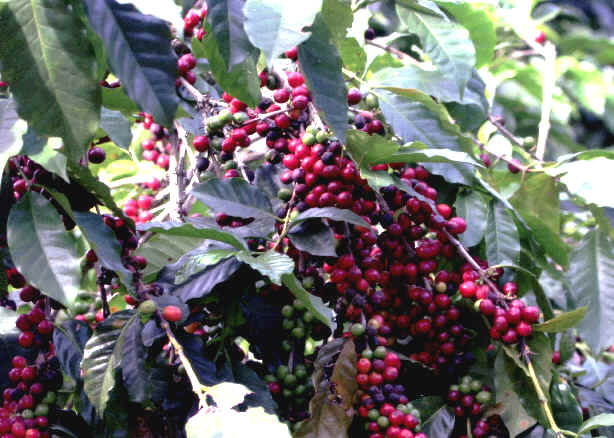


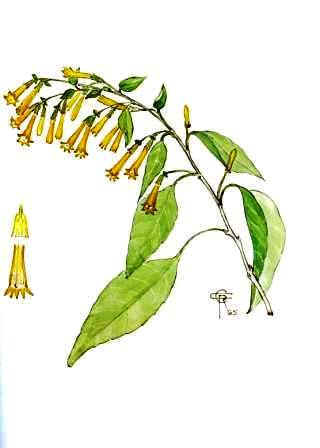
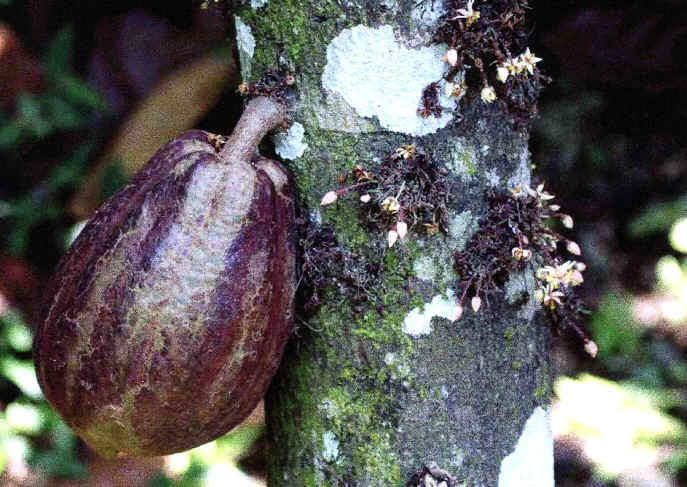


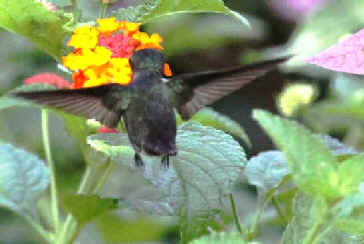


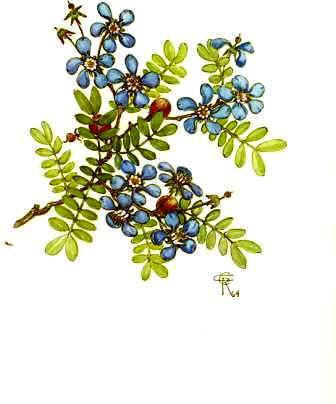
![]()